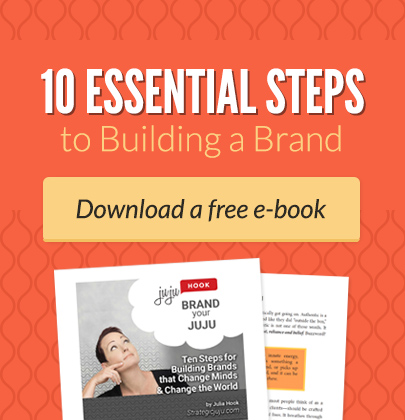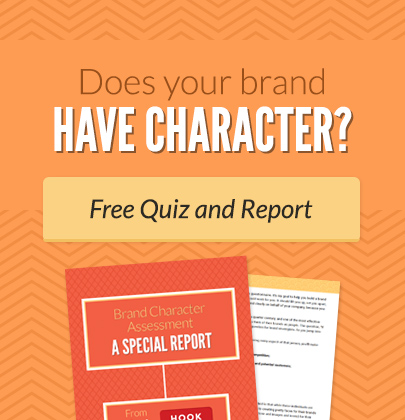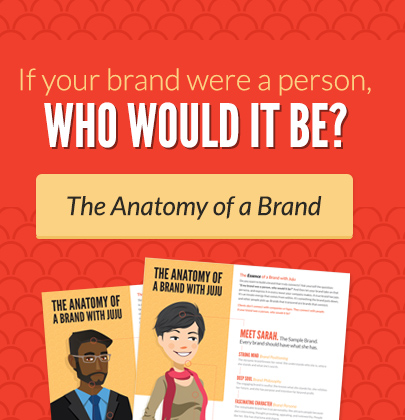You’ve got a client you’re dying to land.
It’s a big one, and you’re nervous about being seen, being heard, being noticed. It’s a huge, digital world out there, and everyone is clamoring for attention.
I get it. I was once starting out. And I had a list of potential big clients I was dying to nail.
Here’s the way it worked for me.
Thirteen years ago, when I left the corporate world and struck out on my own as a marketing and branding consultant, I had a list of exactly zero clients. I had experience and expertise, but no one knew who I was.
I was desperate for a way to be seen and heard.
But how to get the big boys to listen?
I assembled the killer Pitch Pack.
Call me old-fashioned, but a pitch pack is a strategy. And good strategy never goes out of style.
I was fortunate that I had Hook for a last name. It played perfectly into my brand, and I used it for all it was worth. (Think about your name, your experience, a distinguishing characteristic or talent. It will come in handy, I promise.) I wrapped a fishing theme around my name and my game, and set out to get noticed.
- The List. I made a list of 50 big fish I wanted to meet. I wasn’t shy. I chose companies I truly admired, and executives I wanted to align myself with. I took the time to call each company, verify the spelling of the names of the executives I wanted to reach, and their physical work addresses and titles.
- The Individual Need. I identified what it was that each company really needed. Retail companies needed big sales. Financial institutions needed loan volume. Real estate companies needed buyers. I made a list of these specific needs, so I could work them into my messaging.
- The Package. I created a gift with amazing perceived value, entirely branded for my company. Keep in mind my company was a week old. I had no website, no name recognition. No reputation. But I focused on establishing myself as the real deal.
My pitch pack consisted of a fishing hat (the “bucket hat” type) that I ordered from an ad specialties company with my logo embroidered on it. This was the most expensive item in my package, at about $8. I also ordered a slew of hand-made wooden fishing poles from a small supplier, and a bunch of different fishing-related candies (gummy sharks, worms and dirt, Swedish fish). I capped it all off with a “Go Fish” card game, and a bottle of Fish-Eye wine. When the candies arrived (which I had ordered in bulk), I bagged them and put a small logo sticker on each and every bag.
I turned the hats over to use them as buckets, stuffed each one with shredded paper grass in my brand colors, and stood the fishing poles in the middle for stability. I spread the rest of the goodies around, a la Easter Basket, and wrapped each one in a flourish of colored cellophane, with a wired burgundy ribbon around the fishing pole.
My baskets looked professionally-made, well-branded, creative… and expensive. In reality, each one cost less than $20.
- The Card. I had note cards made with my company logo, inexpensively. These were simple cards with nothing more than my logo and a matching envelope.
- The Custom Message. On each card, I crafted a custom message for the outside: “Fishing for new clients?” or “Fishing for more loans?” or “Fishing for big sales?” I ran them through my laser printer and displayed the message in a simple, elegant font.
- The Consistent Hook. On the inside of each card, I wrote my hook-line… my core brand message: “Sometimes, all you need is the right Hook.”
- The Hand-Written Invitation and Request. Inside each note, I hand-wrote a message to the executive I wanted to meet. I introduced myself and said that I would be calling in the near future. And I invited them to enjoy the basket.
- The Delivery. I divided the list into ten groups of five each, and paid someone to deliver the baskets. For ten weeks, I had one basket delivered each day.
- The Research. On the day before delivery, I did as much research as I could about the company receiving the basket. I wanted to be fully prepared to talk to these executives about their marketing needs.
- The Follow-Up Call and the Ask. The day following delivery, I called the executive who had received the prior day’s basket to introduce myself. I was prepared to pitch my services. I asked each and every one for a half hour of their time so that I could meet them.
Do you know what happened?
EVERY SINGLE EXECUTIVE TOOK MY CALL.
Every single one remembered the basket. Every single one said thank you. These were important people, mind you. People who get pitched every day. And I was literally no one to them.
Those 50 basket deliveries lead to seven meetings.
And from those seven meetings, I landed my first three clients.
And in the 13 years that followed, I focused so heavily on building relationships and loyalty for my brand, that I never had to pitch again.
My business grew by word-of-mouth.
I launched my business with $1,000, a sound strategy, and a whole lotta guts.
A Pitch Pack is based on the idea of reciprocity. In exchange for giving something to someone – something I made myself with time, care and attention – I was given permission to ask them for something: a meeting. I didn’t always get what I asked for. But I got noticed. I got permission to ask the question.
We deal with permission marketing on the web every day.
We create great free content, and in exchange, we build a list of email addresses. Folks give us permission to enter their worlds through their email boxes.
The Pitch Pack uses the same permission marketing strategy.
It may seem old-school, but there’s nothing passé or out of style about receiving a thoughtful gift.
Think about how you can create a package that shows your creativity, ingenuity, personality and talent.
How can you take permission marketing to a whole new level, using the oldest trick in the book?
How can you use it to meet influencers in your market? Or affinity partners? Or major clients?
I’d love to hear how you’ve pitched clients. Or how you’d like to. Please share below.





Hi Juju Hook. You are so intensely creative. I have tried a few things for big clients. I was once a Strategic Planning Consultant for a large international Company. I joined one of the largest Rotary Clubs (could be any) in the big business area of my city. I genuinely wanted to be a part of my city and volunteer my services. I got to know a lot of CEOs and executives while painting a school in Mexico and working on committees and even going to parties. Volunteering is good for everyone.
My boss always paid to sit in first class when going to work for a client. He got so many clients for us through those connections. Even though our clients never paid for first class, he paid more and got a lot more.
I follow your site with enthusiasm. Thanks.
Thanks, Sheryl. I love your comments. Your juju sounds amazing. I’m going to pay much closer attention to the person sitting next to me on the plane from now on. Thanks for being here.
I LOVED this reminder, Juju. Your moxie and strategy were refreshing. You have me thinking of ways to break some ice with the hook method. The two things that stuck out to me were being memorable and personal towards the prospects. Those things tend to get lost and watered down in the online world. Thank you for sharing.
Shalenadiva… I’m so glad you enjoyed the post! And I can’t wait to hear about how you break the ice with your clients. I’m so glad to have you here! Stay in touch.
Cheers!
-Juju
Sheryl, you helped me to look at first class differently. I would’ve never thought of leveraging first class seats. THANK YOU FOR THAT!!!! YOU ROCK!!!